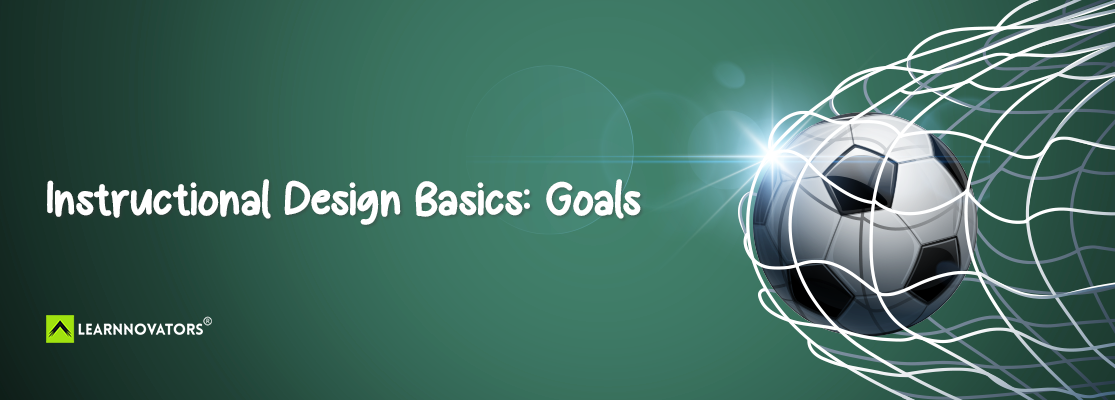“People with goals succeed because they know where they’re going”. – Earl Nightingale
This is true not just at work and in life, but also in instructional design.
Okay, sugary quote aside, goals are really, really important in our work in L&D.
Goals can be thought of as having two parts:
- The first part, at the macro level, should answer the WIIFM (What’s In It For Me) for the business. We’ll call these business goals.
- The second, at the drilled down micro level, should define the specific action(s) learners need to take to reach the goal. These we’ll refer to as learning, or performance, outcomes.
In this article, I focus on the first part – business goals. And the second part, I will address in a subsequent one.
At the macro level, our goal in L&D should answer the WIIFM (What’s In It For Me) for the business. Note that this is different from the learner’s WIIFM. The business goal should explain why they (the organization and its stakeholders) should spend the money, time and resources to develop the course, and what they will get in return. The characteristics of a good goal are that it is:
- Meaningful to business (as we’ve seen above, it should answer the organization’s WIIFM)
- Something that’s achievable through training
- Specific and measurable
Here are a few examples of good goals:
- Improve call center efficiency by 5% in 3 months.
- Increase claim form accuracy by 25% in Q4.
- Reduce service complaints to just 2 / month by June.
Let’s take the first example above (Improve call center efficiency by 5% in 3 months), and break it down to see if the three characteristics of a good goal are satisfied.
- Is it meaningful to business? Yes. Improving the efficiency of the call center is something that the organization cares about, and hence they would be willing to invest money and resources towards achieving the goal.
- Is it achievable through training? A skill gap exists, and if the employees of the call center are given proper training, this skill gap will close, and hence the efficiency of the call center will improve.
- Is it specific and measurable? Absolutely, yes.
Note that goals are one of the end results of your analysis process. A challenge that you will continually face in defining good goals is that your stakeholders will often tell you to “just create a course”. Or that, “learners just need to know this”.
Let’s take the same example above and see how that might happen. It’s possible that your stakeholder might come to you and say, “We want to create a course on our new call resolution process”.
How do we determine that a real problem exists that can be solved through training? And then how do we derive a good goal from the one given by the stakeholder above?
By asking probing questions.
Here’s a likely conversation that might happen between you (the instructional designer) and your stakeholder.
Bad goal given by the stakeholder: We want to create a course on our new call resolution process.
Conversation between you and your stakeholder:
- You: What makes you believe that people are not using the new call resolution process?
- Stakeholder: In our mock call sessions, we understood that people are not aware of the nuances of the new process. Plus, we listened to call recordings which confirmed this.
- You: How do you think following the new process will improve call resolution results?
- Stakeholder: It will help them focus on first call closure. This means lesser time on calls with the same client, better efficiency of the call center staff, and more satisfied clients!
- You: So, do you think we can use this as a goal for our course: Improve call center efficiency by 5% in 3 months?
- Stakeholder: Sure, that sounds reasonable.
Note that while the conversation above looks neat and succinct, and we converted a bad goal into a good one in less than five questions, it rarely ever happens so in real life. The important thing is to not get frustrated, and not give up hope that it is possible. Keep probing until you get to a goal that is meaningful.
Here are a few more questions that can help in arriving at a good goal:
- What would be a measure of success for this course?
- What is happening currently with respect to this need? How are people handling it?
- Have you tried anything to address this so far? What were the results?
A note about understanding whether the goal can be reached by training. Consider this example:
“Malware attacks should decrease by 20% by year end.”
At first glance, it’s not clear whether training can solve this problem at all. Malware attacks could be happening because:
- Employees are not taking enough precautions in their systems. They are not being careful enough, or they don’t know what they need to do. If this is the case, it is absolutely a training problem, and you can create a course to address it. Please note that there are nuances even here, which we’ll address in the next article on learning outcomes.
(or)
- The organizational systems are not strong enough to prevent malicious attacks from happening. As you’d have guessed, this is NOT a training problem. It probably means that the systems need to be fixed, by adding (or updating) software to make the infrastructure more robust. Creating a course when this is the case would not only be ineffective; it might also backfire by causing additional problems.
And this is what your analysis should uncover. By asking the important probing questions, we must get to the root of the problem, and then determine whether a course is really needed or not.
A note about measurability. Use metrics that the organization is already measuring. Sometimes it’s possible that no metrics are available to measure. In that case, still make the goal useful to business.
Metrics are negotiable, a meaningful goal is not.
Well, what if we measure, and can’t hit the target? Wouldn’t our solution be labelled as bad?
I hear you! Considering this question, you may feel it’s safer to just create the course that the client asks for.
Cathy Moore has great advice for us in this regard. She says, “…it’s best to consider it a goal, not a guarantee…”, and “…if we target the right behaviors, we could meet it.”
Now, here are a few example goals for you to consider. Have a look at them, and using the three-point characteristics above, think of whether they can be considered good goals or not. The answers are given below, but I’d ask you to think about each statement before looking at the answers.
- Employees should understand the importance of our new process.
- The team should be able to produce 6% more machines in Q3.
- Sales people should know all about our products so they can sell better.
Answers:
- Employees should understand the importance of our new process. This is not meaningful to business, and hence is not a good goal.
- The team should be able to produce 6% more machines in Q3. This ticks the box for all three characteristics, and so is a good goal.
- Sales people should know all about our products so they can sell better. While “sell better” is meaningful to business, it’s not specific or measurable.
So, what are your thoughts? I’d love to hear from you.
Written by Srividya Kumar, Co-Founder @ Learnnovators








